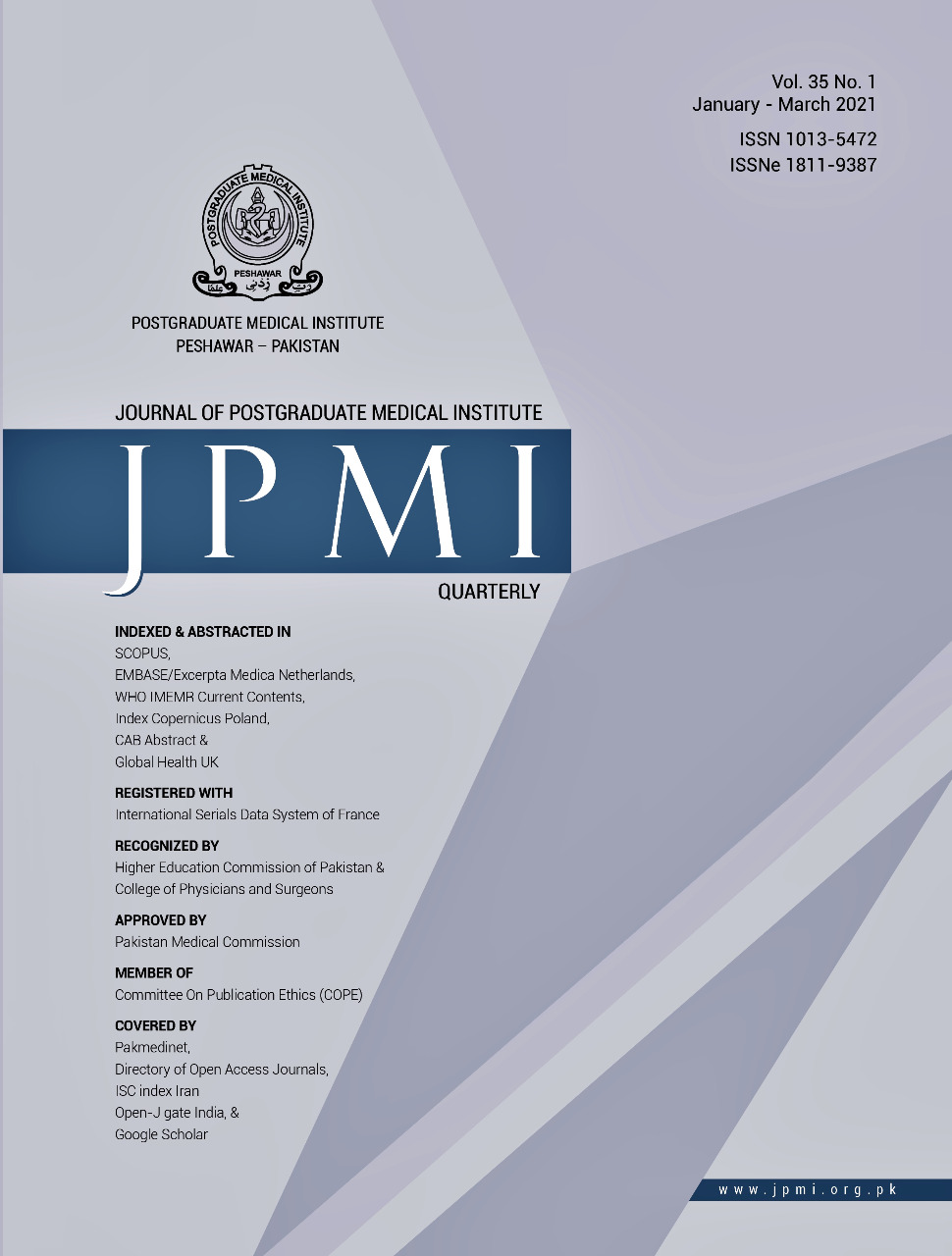COMPARISON OF ADVERSE FETOMATERNAL OUTCOME IN EARLY AND LATE ONSET PRE ECLAMPSIA
Main Article Content
Abstract
Objective: To compare adverse feto-maternal outcome between women with early and late onset preeclampsia.
Methodology: This cross sectional study was conducted in Gynecology and Obstetrics and Gynecology Department, Lady Reading Hospital, Peshawar from March 2016 to September 2016. A total of 254 patients having singleton pregnancy of more than 20 weeks were included. Week 34 was used as a cutoff to classify patients into Early Onset Preeclampsia (EOPE) and Late Onset Preeclampsia (LOPE). All the subjects were followed up till one week after delivery to compare adverse fetomaternal outcome. SPSS version 25 was used for data analysis.
Results: Out of 254 patients, 172 (67.7%) patients had LOPE while 82 (32.3%) presented with EOPE. The mean Body Mass Index (BMI) for EOPE and LOPE was 25.25±1.70kg/m2 and 25.97±2.03kg/m2, respectively. Most of the patients were multigravida in both groups, 43 (52.4%) in EOPE and 122 (70.93%) in LOPE. Preterm birth was more common in the EOPE (n=49, 59.75%) as compared to LOPE (n=60, 34.88%) with a p-value of 0.0001. LOPE group had more cesarean sections (n=62, 36.02%) than EOPE (n=16, 19.53%) with a p-value of 0.008. Neonatal Intensive Care Unit (NICU) admissions were more common in EOPE group (60.92%) as compared to LOPE (41.82%) having a p-value of 0.004. Neonatal deaths and small for gestational age was found to be insignificant in the two groups.
Conclusion: Preterm birth and NICU admissions were more common in EOPE while cesarean section was more commonly done in LOPE.
Article Details
Work published in JPMI is licensed under a
Creative Commons Attribution-NonCommercial 2.0 Generic License.
Authors are permitted and encouraged to post their work online (e.g., in institutional repositories or on their website) prior to and during the submission process, as it can lead to productive exchanges, as well as earlier and greater citation of published work.
References
JT, Thompson JH, Burda BU, Cantor A. Preeclampsia screening: evidence report and systematic review for the US Preventive Services Task Force. JAMA. 2017;317(16):1668-83. https://doi.org/10.1001/jama.2016.18315
Jeyabalan A. Epidemiology of preeclampsia: impact of obesity. Nutrition Rev.2013;71(suppl-1):S18-25. https://doi.org/10.1111/nure.12055
Kaze FF, Njukeng FA, Kengne AP, Ashuntantang G, Mbu R, Halle MP, et al. Post-partum trend in blood pressure levels, renal function and proteinuria in women with severe preeclampsia and eclampsia in Sub-Saharan Africa: a 6-months cohort study. BMC Pregnancy Childbirth. 2014;14:134. https://doi.org/10.1186/1471-2393-14-134.
Jabeen M, Yakoob MY, Imdad A, Bhutta ZA. Impact of interventions to prevent and manage preeclampsia and eclampsia on stillbirths. BMC Public Health. 2011;11(3):1-4. https://doi.org/10.1186%2F1471-2458-11-S3-S6
Mir AM, Pearson S, Shaikh S, Khan M, Masud I, Hussain S. Maternal Mortality due to Eclampsia in Khyber Pakhtunkhwa: Identifying Underlying Risk Factors, and Care-seeking Behaviours. J Pak Med Assoc. 2019;69(7):934-8.
Singh R, Tandon I, Deo S, Natu SM. Does microalbuminuria at mid-pregnancy predict development of subsequent pre-eclampsia?. J Obstet Gynaecol Res. 2013;39(2):478-83. https://doi.org/10.1111/j.1447-0756.2012.01988.x
Akolekar R, Syngelaki A, Sarquis R, Zvanca M, Nicolaides KH. Prediction of early, intermediate and late preeclampsia from maternal factors, biophysical and biochemical markers at 11–13 weeks. Prenat Diagn. 2011;31(1):66-74. https://doi.org/10.1002/pd.2660
Conde-Agudelo A, Romero R, Kusanovic JP, Hassan SS. Supplementation with vitamins C and E during pregnancy for the prevention of preeclampsia and other adverse maternal and perinatal outcomes: a systematic review and metaanalysis. Am J Obstet Gynecol. 2011;204(6):503-e1. https://doi.org/10.1016/j.ajog.2011.02.020
Webster K, Fishburn S, Maresh M, Findlay SC, Chappell LC. Diagnosis and management of hypertension in pregnancy: summary of updated NICE guidance. BMJ. 2019 Sep 9;366:https://doi.org/10.1136/bmj.l5119
Brown MC, Best KE, Pearce MS, Waugh J, Robson SC, Bell R. Cardiovascular disease risk in women with pre-eclampsia: systematic review and meta-analysis. Eur J Epidemiol. 2013;28(1):1-9. https://doi.org/10.1007/s10654-013-9762-6
Aviram A, Barrett J, Zaltz A, Sherman C, Kingdon J, Melamed N. 426: Defining the gestational age cut-off between early and late preeclampsia in singletons. Am J Obstet Gynecol. 2019;220(1):S289. https://doi.org/10.1016/j.ajog.2018.11.447
Wojtowicz A, Zembala-Szczerba M, Babczyk D, Kolodziejczyk-Pietruszka M, Lewaczynska O, Huras H. Early-and late-onset preeclampsia: a comprehensive cohort study of laboratory and clinical findings according to the New ISHHP criteria. Int J Hypertens. 2019;2019:1-9. https://doi.org/10.1155/2019/4108271
Parra-Cordero M, Rodrigo R, Barja P, Bosco C, Rencoret G, Sepúlveda-Martinez A, et al. Prediction of early and late pre-eclampsia from maternal characteristics, uterine artery Doppler and markers of vasculogenesis during first trimester of pregnancy. Ultrasound Obstet Gynecol. 2013;41(5):538-44. ttps://doi.org/10.1002/uog.12264
Shamsi U, Hatcher J, Shamsi A, Zuberi N, Qadri Z, Saleem S. A multicentre matched case control study of risk factors for preeclampsia in healthy women in Pakistan. BMC Womens Health. 2010;10(1):1-7. https://doi.org/10.1186/1472-6874-10-14
Perveen S. Frequency and impact of hypertensive disorders of pregnancy. J Ayub Med Coll Abbottabad. 2014;26(4):518-21.
Gomathy E, Akurati L, Radhika K. Early onset and late onset preeclampsia-maternal and perinatal outcomes in a rural teritiary health center. Int J Reprod Contracept Obstet Gynecol. 2018;7(6):2266-9. https://dx.doi.org/10.18203/2320-1770.ijrcog20182333
Hernández-Díaz S, Toh S, Cnattingius S. Risk of pre-eclampsia in first and subsequent pregnancies: prospective cohort study. BMJ. 2009;338 https://doi.org/10.1136/bmj.b2255
Bozdag H, Ogutcuoglu FB, Guzin K, Kilic SR, Duran EA, Aydin IT. The frequency and fetomaternal outcomes of early-and late-onset preeclampsia: The experience of a single tertiary health center in the bustling metropolis of Turkey; Istanbul. Medeniyet Med J. 2015;30(4):163-9. https://doi.org/10.5222/MMJ.2015.163
Coviello EM, Iqbal SN, Grantz KL, Huang CC, Landy HJ, Reddy UM. Early preterm preeclampsia outcomes by intended mode of delivery. Am J Obstet Gynecol. 2019;220(1):100-e1. https://doi.org/10.1016/j.ajog.2018.09.027
Nassar AH, Adra AM, Chakhtoura N, Gómez- Marín O, Beydoun S. Severe preeclampsia remote from term: labor induction or elective cesarean delivery?. Am J Obstet Gynecol. 1998;179(5):1210-3. https://doi.org/10.1016/s00029378(98)70133-4


